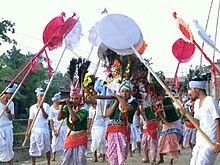| Lai Haraoba | |
|---|---|
| Official name | Lai Haraoba |
| Also called |
|
| Observed by | Meitei people |
| Frequency | annual |
| Related to | Umang Lais |
| Part of a series on |
| Sanamahism |
|---|
 |
| Primordial deities |
| Incarnations |
Scripture
|
| Religious roles |
| Temples |
| Festivals |
Lai Haraoba (Meitei for 'merry making of the gods') is a traditional Meitei religious festival of ritual dance and musical theatre, celebrated annually in honour of Umang Lais, the forest deities of Sanamahism (traditional Meitei religion).


Origin

Lai Haraoba (Meitei: ꯂꯥꯏ ꯍꯔꯥꯎꯕ) is a ritualistic festival of the Meiteis observed since ancient times. It is a ritual enactment of the creation myth. It mirrors the entire culture of Manipur and depicts the close affinities between the hill and plain people. It is a combination of religious recitations, traditional music and dance, traditional social values and ancient cultural aspects.
The rituals within the festival are the same except in some items or hymns, such as ikouba, ikourol, and yakairol at the beginning and mikon thagonba, ngaprum tanba at the end of the festival. In the performances, the evolution story with the amorous love-affairs of Nongpok Ninghthou and Panthoibi is depicted and played equally in all kinds of lai haraoba. According to folklore, the gods held the first Lai Haraoba on the Koubru Hill so that their descendants would imitate them by performing the same rites.

Types and variations
Four types of Lai Haraoba are prevalent in the Meitei society, namely, Kanglei Haraoba, Moirang Haraoba, Kakching Haraoba and Chakpa Haraoba. Kanglei Haraoba is performed mainly in Imphal and the nearby towns. Moirang Haraoba is only in Moirang, Kakching Haraoba is held in Kakching and Chakpa Haraoba is celebrated at Andro, Phayeng, Sekmai, Koutruk, Khuukhul, Leimaram and Tairenpokpi.
Lai Haraoba Ishei
Lai Haraoba Ishei is a famous folk song played mainly during Lai Haraoba. This song contains lyrics with veiled references to erotic mysticism. The main quality of the song is the rhythm in its tune.

See also
References
- Samson, Kamei (2015). "Social Change among the Tribes of Manipur Valley: A Case Study of Rongmei". Sociological Bulletin. 64 (3): 356–374. doi:10.1177/0038022920150305. ISSN 0038-0229. JSTOR 26290747. S2CID 157747894.
- Ayyappapanicker, K.; Sahitya Akademi (1997). Medieval Indian Literature: An Anthology. Sahitya Akademi. p. 330. ISBN 978-81-260-0365-5.
- Acharya, Amitangshu; Soibam Haripriya (27 July 2007). "Respect to foster unity in cultural mosaic - festival/lai haraoba". The Telegraph. Archived from the original on 3 February 2013. Retrieved 5 November 2008.
- "Rich traditions seek to revive Manipur's Lai Haraoba festival". www.freepressjournal.in. Retrieved 5 May 2022.
- "Workshop on making of "Laipot-Senpot" of Umang Lai Haraoba kicks off". themorningbell.in. Retrieved 5 May 2022.
- Allen, N. J. (1999). "Review of The Pleasing of the Gods: Meitei Lai Haraoba". Bulletin of the School of Oriental and African Studies, University of London. 62 (1): 160–161. doi:10.1017/S0041977X00017973. ISSN 0041-977X. JSTOR 3107431. S2CID 161513835.
- "LAI HARAOBA – THE MOST IMPORTANT FESTIVAL (Merry Making of Umanglai) - Imphal Times". www.imphaltimes.com. July 2018. Retrieved 5 May 2022.
- "5 facts to know about 'Lai Haraoba' the ancient dance form of Manipur!". thenortheasttoday.com. 9 January 2017. Retrieved 5 May 2022.
- MCDUIE-RA, DUNCAN (2012). "The 'North-East' Map of Delhi". Economic and Political Weekly. 47 (30): 69–77. ISSN 0012-9976. JSTOR 23251770.
- Devi, Khwairakpam Renuka (2011). "Representation of the Pre-Vaishnavite Culture of the Meiteis: "Cheitharol Kumpapa" of Manipur". Proceedings of the Indian History Congress. 72: 501–508. ISSN 2249-1937. JSTOR 44146744.
- "Lai Haraoba Ishei". India9.com. 7 June 2005. Retrieved 5 November 2008.
- Parratt, Saroj Nalini; John Parratt (1997). The Pleasing of the Gods: Meitei Lai Haraoba. Vikas Publishing House.
Further reading
- Kshetrimayum, Otojit. (2014). Ritual, Politics and Power in North East India: Contexualising the Lai Haraoba of Manipur. New Delhi: Ruby Press & Co.